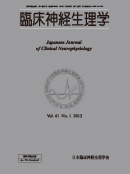Volume 41, Issue 2
Displaying 1-9 of 9 articles from this issue
- |<
- <
- 1
- >
- >|
General Reviews
-
2013 Volume 41 Issue 2 Pages 57-70
Published: April 01, 2013
Released on J-STAGE: February 25, 2015
Download PDF (1031K) -
2013 Volume 41 Issue 2 Pages 71-79
Published: April 01, 2013
Released on J-STAGE: February 25, 2015
Download PDF (766K)
Special Features
-
2013 Volume 41 Issue 2 Pages 80-85
Published: April 01, 2013
Released on J-STAGE: February 25, 2015
Download PDF (799K) -
2013 Volume 41 Issue 2 Pages 86-92
Published: April 01, 2013
Released on J-STAGE: February 25, 2015
Download PDF (1059K)
Special Features
-
2013 Volume 41 Issue 2 Pages 93
Published: 2013
Released on J-STAGE: February 25, 2015
Download PDF (517K) -
2013 Volume 41 Issue 2 Pages 94-102
Published: April 01, 2013
Released on J-STAGE: February 25, 2015
Download PDF (1474K) -
2013 Volume 41 Issue 2 Pages 103-111
Published: April 01, 2013
Released on J-STAGE: February 25, 2015
Download PDF (1414K) -
2013 Volume 41 Issue 2 Pages 112-117
Published: April 01, 2013
Released on J-STAGE: February 25, 2015
Download PDF (778K) -
2013 Volume 41 Issue 2 Pages 118-123
Published: April 01, 2013
Released on J-STAGE: February 25, 2015
Download PDF (1074K)
- |<
- <
- 1
- >
- >|
